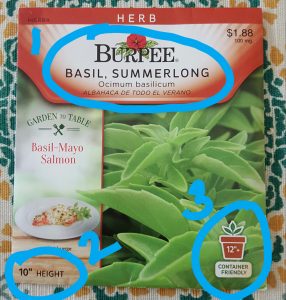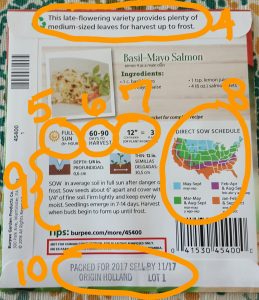If you want to learn how to garden, you must first learn how to read a seed packet. Your seed packet contains 10 vital bits of valuable info which will provide you with guidance. This information will be a key to successful gardening!
About two weeks ago, I wrote a post called Vegetable Gardening for Beginners: 5 Easy Tips for Success. Shortly after I published this article, I received an email in which I was rightfully chided for skipping a glaringly obvious step…checking to see if the seeds are even compatible for your particular environment. After all, you can’t grow cranberries in the desert!
RELATED POST: Garden Nightmares (and how to deal with them)
That email slowed me down. I re-read the article and realized that because I have been around gardens for my entire life, I didn’t even consider that some people don’t know the first thing. So while I shared tips that are certainly useful and valid, I skipped a very important basic. Perhaps one of the first things you need to know is how to read a seed packet.
In fact, the seed packet speaks volume about the plant which you are cultivating. It doesn’t matter if it’s a vegetable, herb, annual flower, or ornamental grasses. No matter. The seed packet is where you look for information on your planting project.
Let me start by saying that no two seed brands package the exact same way. The information I am sharing with you is going to be on the packet; however, you may need to search for it from brand to brand. This will vary. Frustrating, true. But once you get accustomed to looking, you will learn to read them easily.
The photo I have uploaded is a pack of seeds that I had on hand. It happens to be Burpee Basil. I have taken a photo of the front and the back of the packet and numbered each important piece of information. Let’s take a look at it together now.

ITEM 1-PLANT NAME
Item 1 is the brand name and plant’s common name. You will see this on every seed packet. The variation may or may not be located right below that. In this case, it is. Burpee packets do carry this on all their packets.
ITEM 2 – OVERALL PLANT HEIGHT
Item 2 gives you a rough estimate of how tall your plant will be. This basil will grow to about 10″ high.
ITEM 3 – CONTAINER GARDEN INFORMATION
Item 3 shows you that this basil is safe to grow in container gardens. Containers need to be 12″ in size. Here’s where this can get tricky. Some seed companies put this on the front. Others simply say “container friendly” either on the front or the back. Still others tell you what size.
Here’s where this can get tricky. Some seed companies put this on the front. But some simply say “container friendly” either on the front or the back. Yet some others tell you what size container you should place your seeds in. However, some don’t tell you.
A good rule of thumb for container gardening is to choose a pot with a diameter equal to or larger than the estimated height of the plant. You can plant 3 or 4 of the same plants in the container. You want the roots to be able to take firmly into the soil. Plus, the plant needs plenty of space to grow.

ITEM 4- INFORMATION ON YOUR GROWING SEASON
Someplace on the back of the seed packet, you will find out the length of time that the plant will flourish. Herbs like basil, for example, are good from spring through fall. However, lettuce will droop in most climates once the daily temperature keeps above 80.
If you are in a cooler climate, you could have success with cool weather crops into the early part of July. However, in the south, you would rotate in a new crop after spring. These bits of insight will help you decide if you want to plant a particular item or move on to something that will fare better in your region.
ITEM 5 – HOW TO DETERMINE A PLANTING LOCATION
All seed packets will indicate, in some place or another, what growing conditions you need. In this example, the sweet basil needs full sun. This tells you…you got it, put it in the full sun.
The most common terms are the following: “full sun,” “partial sun or sun/shade” and “full shade”. Different seed companies have different terms. But you get the idea… read this before you decide the planting location for your garden.
ITEM 6 – HOW LONG DOES IT TAKE A PLANT TO GROW?
Item 6 answers the burning question that every gardener has: How long will it take to grow my plant? This information is printed on every seed package. It tells you how many days it will take you from seeding to harvesting. If you’re in a location with a long growing season, this basil could produce several harvests for you.
ITEM 7 – CONTAINER GARDEN INFORMATION
Container gardens are great. I love them. However, they aren’t appropriate for every plant. Some plants, like watermelons, just require too much space to be super successful in containers. Other plants, like rosemary, thrive in container garden settings.
Some companies (not all) make it very clear when you can successfully use container garden methods. Burpee is wonderful about this. Not all manufacturers give this much guidance. For some, it’s unfortunately just trial and error.
ITEM 8 – WHEN TO PLANT YOUR GARDEN
Item 8 is one every single package of seeds sold in the USA. It’s a little color-coded map that tells you when to plant your seeds. If you plant too early, you run the risk of frost damage. If you plant too late, your plants could wither in the heat.
Pay attention to this information, it’s one of the most important tools on the seed packet.
ITEM 9: HOW TO PLANT SEEDS
Item 9 will be found on every seed package, although it may be at the top corner. This gives you detailed information on how to plant the seeds, how far apart to plant the seeds, and follow-up care for the seedlings after they pop up.
These instructions are tested by professional growers. This is the most valuable information that you must follow.
ITEM 10: SEED EXPIRATION DATE
All seed packets contain an expiration date. While some people claim they keep seeds from year to year, seed producers don’t recommend it. As seeds age, they become less fertile. Your chances of a successful garden are far greater if you do plant the seeds before they expire.
In conclusion, I do hope this rather long post gives you the valuable tools you need when you want to learn to garden. Indeed, starting from the very first step is important for a beginner. My apologies for putting the cart before the horse in my previous article.
Happy Gardening!

